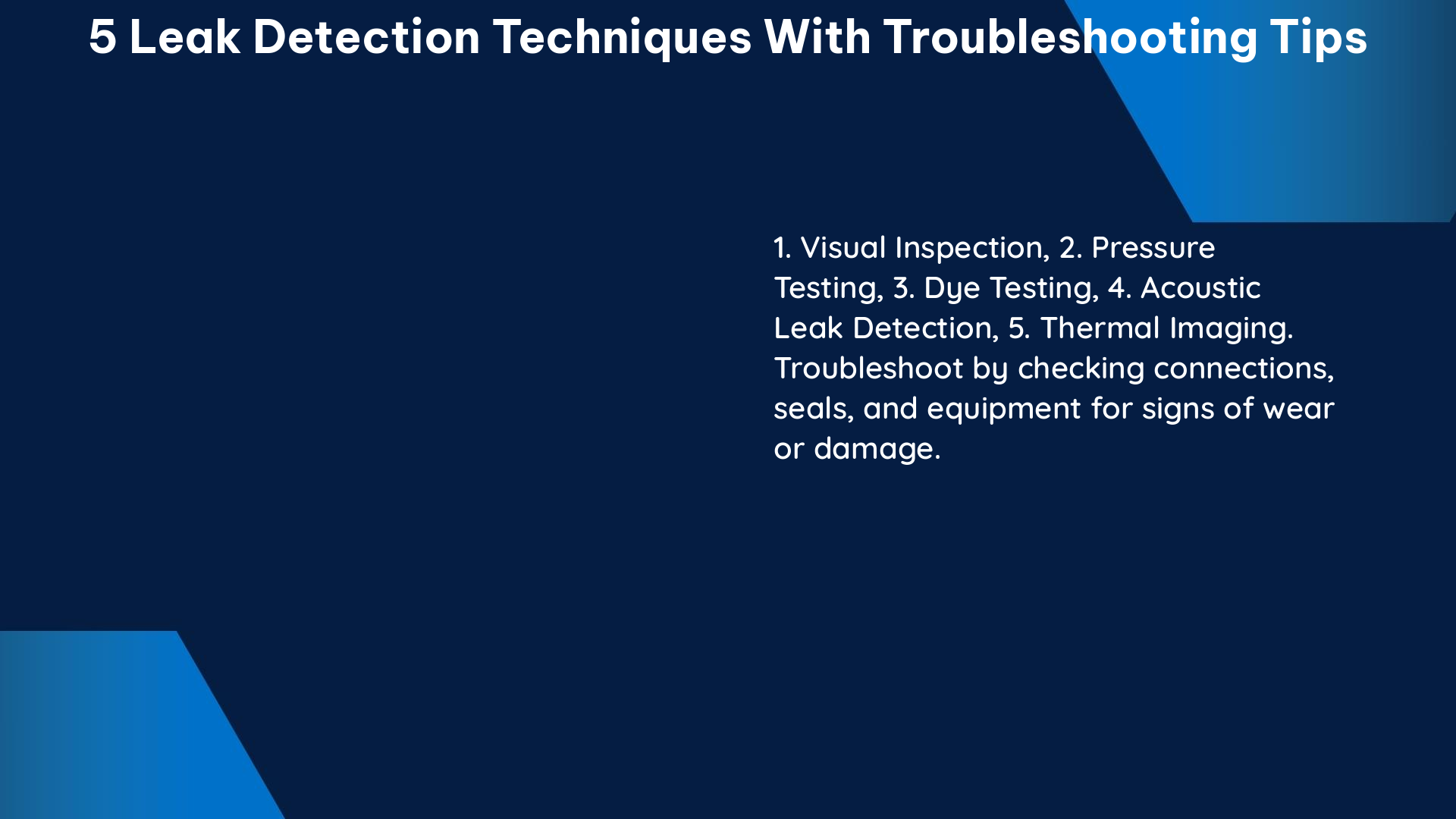Leak detection is a critical aspect of maintaining the integrity and safety of various systems, from industrial equipment to household appliances. In this comprehensive guide, we will explore five advanced leak detection techniques, providing you with a detailed understanding of their principles, technical specifications, and troubleshooting tips to ensure accurate and reliable leak detection.
1. Pressure Decay Method
The Pressure Decay Method is a widely used technique for detecting leaks in sealed systems. It involves measuring the pressure inside a chamber before and after a suspected leak has occurred, with the difference in pressure used to calculate the leak rate.
Technical Specifications:
– Pressure Transducers: Range of 0-100 psi (0-690 kPa), accuracy of ±0.25% full scale
– Pressure Source: Stable air compressor or nitrogen source
– Chamber: Sealed and insulated, free from drafts or other sources of pressure fluctuation
Troubleshooting Tips:
1. Ensure the pressure source is stable and free from fluctuations.
2. Verify the calibration of the pressure transducers to maintain accuracy.
3. Inspect the chamber for any potential sources of pressure leaks, such as cracks, seals, or openings.
4. Monitor the chamber for environmental factors that could affect pressure, such as temperature changes or air currents.
2. Vacuum Decay Method

The Vacuum Decay Method is similar to the Pressure Decay Method, but instead of measuring pressure, it measures the vacuum inside a sealed chamber before and after a suspected leak has occurred. The difference in vacuum is then used to calculate the leak rate.
Technical Specifications:
– Vacuum Transducers: Range of 0-100 inHg (0-33 kPa), accuracy of ±0.25% full scale
– Vacuum Source: Stable vacuum pump
– Chamber: Sealed and insulated, free from drafts or other sources of vacuum fluctuation
Troubleshooting Tips:
1. Ensure the vacuum source is stable and capable of maintaining a consistent vacuum level.
2. Verify the calibration of the vacuum transducers to maintain accuracy.
3. Inspect the chamber for any potential sources of vacuum leaks, such as cracks, seals, or openings.
4. Monitor the chamber for environmental factors that could affect the vacuum, such as temperature changes or air currents.
3. Halogen Diode Method
The Halogen Diode Method uses a specialized sensor to detect the presence of halogen gases, such as Freon, in a system. The sensor is calibrated to detect a specific concentration of halogen gas, and the leak rate is calculated based on the rate of increase in halogen gas concentration.
Technical Specifications:
– Halogen Diode Sensor: Sensitivity of 1 ppm (parts per million) or better
– System: Free from halogen gas contamination
Troubleshooting Tips:
1. Ensure the halogen diode sensor is properly calibrated to detect the target halogen gas.
2. Verify that the system being tested is free from any sources of halogen gas contamination, which could interfere with the leak detection process.
3. Monitor the sensor for any signs of degradation or drift, which could affect its accuracy.
4. Ensure the system being tested is stable and free from any external factors that could influence the halogen gas concentration.
4. Mass Spectrometer Method
The Mass Spectrometer Method uses a highly sensitive instrument to detect the presence of specific gases in a system. The mass spectrometer is calibrated to detect a specific concentration of gas, and the leak rate is calculated based on the rate of increase in gas concentration.
Technical Specifications:
– Mass Spectrometer: Sensitivity of 1 ppm (parts per million) or better
– System: Free from gas contamination
Troubleshooting Tips:
1. Ensure the mass spectrometer is properly calibrated to detect the target gas.
2. Verify that the system being tested is free from any sources of gas contamination, which could interfere with the leak detection process.
3. Monitor the mass spectrometer for any signs of drift or instability, which could affect its accuracy.
4. Ensure the system being tested is stable and free from any external factors that could influence the gas concentration.
5. Ultrasonic Method
The Ultrasonic Method uses high-frequency sound waves to detect the presence of leaks in a system. The ultrasonic waves are generated by a transducer, and the leak is detected by the presence of ultrasonic noise.
Technical Specifications:
– Transducer: Frequency range of 20 kHz to 100 kHz, sensitivity of 1 mV/Pa or better
– Detection Equipment: Sensitivity of 1 mV or better
Troubleshooting Tips:
1. Ensure the transducer is properly positioned and oriented to effectively detect the ultrasonic noise generated by the leak.
2. Verify the calibration of the detection equipment to maintain sensitivity and accuracy.
3. Identify and eliminate any sources of background ultrasonic noise that could interfere with the leak detection process.
4. Ensure the system being tested is stable and free from any external factors that could influence the ultrasonic noise levels.
By understanding the technical specifications and troubleshooting tips for each of these advanced leak detection techniques, you can ensure accurate and reliable leak detection in a wide range of applications, from industrial equipment to household systems.
References:
1. Leak Detection Study – DTPH56-11-D-000001, Kiefner and Associates, Inc., December 2012.
2. Standard Test Procedures for Evaluating Leak Detection Methods, EPA, March 2014.
3. Fundamentals of leak detection, Leybold, January 2017.
4. Leak Detection Methods, Thomasnet, 2010.
5. QUANTITATIVE LEAK TEST DESIGN GUIDE, J. L. Manganaro, NASA, 1967.

The lambdageeks.com Core SME Team is a group of experienced subject matter experts from diverse scientific and technical fields including Physics, Chemistry, Technology,Electronics & Electrical Engineering, Automotive, Mechanical Engineering. Our team collaborates to create high-quality, well-researched articles on a wide range of science and technology topics for the lambdageeks.com website.
All Our Senior SME are having more than 7 Years of experience in the respective fields . They are either Working Industry Professionals or assocaited With different Universities. Refer Our Authors Page to get to know About our Core SMEs.